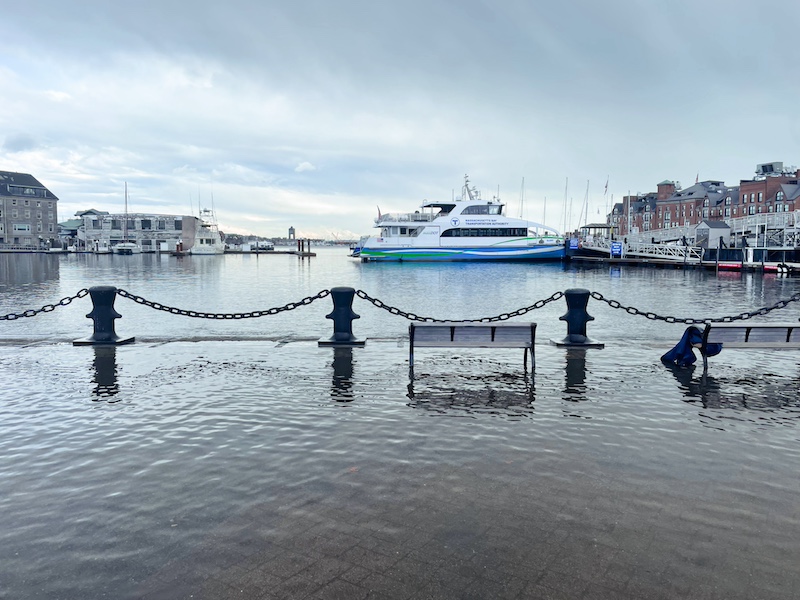
Sea water floods a pedestrian walkway in Boston's North End after a storm. Credit: Anxhela Mile.
Winter days balmy enough for shirtsleeves, followed by record-setting polar-vortex lows. Day after day of blue skies, followed by torrential rains. Jungle humidity, then air so dry that skin feels like sandpaper. Snowfall that melts in a day, then floods. There is an informal term for all these weird back-and-forth weather extremes we’re witnessing: weather whiplash. We’re all seeing it and grappling with its effects, whether it’s dealing with the small inconvenience of a canceled ski trip because there’s no snow or the major trauma of having to rebuild our lives after a flood has washed away our homes or businesses.
Scientists are unequivocal about what has us tossing frisbees in shorts one moment and digging through three-foot snowdrifts the next: climate change caused by the burning of fossil fuels.
According to a study at Stanford University, rising temperatures intensify the unpredictability of weather in the planet’s midlatitudes. That’s us. And by now, it is well-documented that climate change is resulting in widespread changes in weather patterns that include more frequent and severe weather extremes. Those include storms, droughts, heat waves, and wildfires – and the flooding, air pollution, and other fallout that comes with them. And certainly, we’ve seen all of it in the last few years. Especially in New England, which is warming faster than any other part of the country.
These are changes that we can see and feel, but that doesn’t mean there aren’t solutions.
Unpredictable Extremes Are Dangerous
If this were all simply a matter of the inconvenience of making space in a carry-on for both a swimsuit and a snowsuit, it would be mostly just annoying. But this is a much more serious business that caused $92.9 billion in damage around the country in 2023 alone. For one, our infrastructure is not designed to withstand such extremes. Our cities and towns are not built to absorb torrential rains, as we witnessed in both the summer and December of 2023. And in temperate regions like New England, our cities, neighborhoods, and homes have not been built to cope with extreme heat, either.
Public transit systems and the steel tracks that trains move on strain when temperatures bounce from frigid to flaming. Utilities fail during both snowstorms and heat waves.
Nature suffers, too – heavy rains, droughts, and extreme heat or frigid cold damage crops. Forests struggle. Trees become more vulnerable to wildfire and insect infestations. In short, the fallout from climate change-induced weather whiplash extends beyond personal comfort to the well-being of the next generation and the planet.
We can no longer simply cross our fingers and hope to ride out the next cold snap, heat wave, or bad storm. We need to prepare. And while we can’t eliminate unpredictability and weather extremes entirely, we can learn to adapt to them.
Adaptation and Climate Resiliency Can Help Us Cope
So, what can we do today, in the face of unpredictable weather extremes that bounce between bitter cold and broiling, sometimes in just an afternoon?
The short answer: We must get ready and plan intensively for the effects of climate while there’s still time.
We must invest in infrastructure and urban planning to allow our utilities, public transit, neighborhoods, and homes the adaptability they need to handle extreme weather. We need to build innovative, nature-based solutions, like green corridors, rain gardens, wetlands, and parks to absorb floodwater after storms. We should plant more trees to create a lush tree canopy to cool neighborhoods in the summer heat. Utilities companies must upgrade to protect our electrical grid, including reinforcing, or burying power lines. Adding more microgrids independent of a centralized grid can also help us maintain power during a heat wave or after a big storm.
Fossil Fuel Use is Causing Our Weather Whiplash
Scientists have told us what’s at the root of all this for decades – fossil fuels. It’s time to quit our fossil fuel habit and use clean alternatives like offshore wind and solar power. By doing so, we may have a crack at stabilizing our climate – and, by extension, erratic weather – and that would be a blessing not only for ourselves but coming generations.
Coping with weather whiplash is about so much more than keeping both snow boots and sandals in the boot tray at the front door. It’s about prioritizing resiliency and adaptation for the sake of all of us. Waiting for later is just too late.




